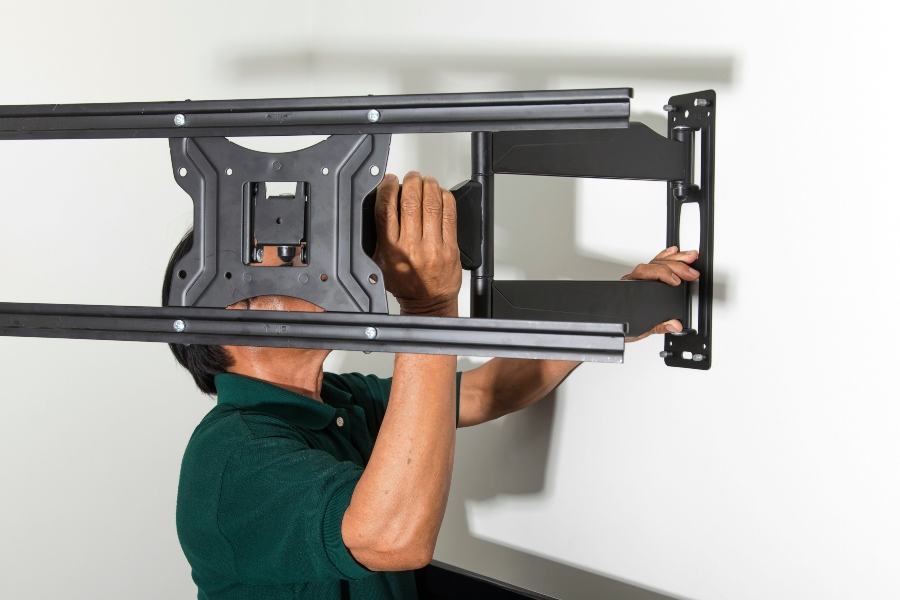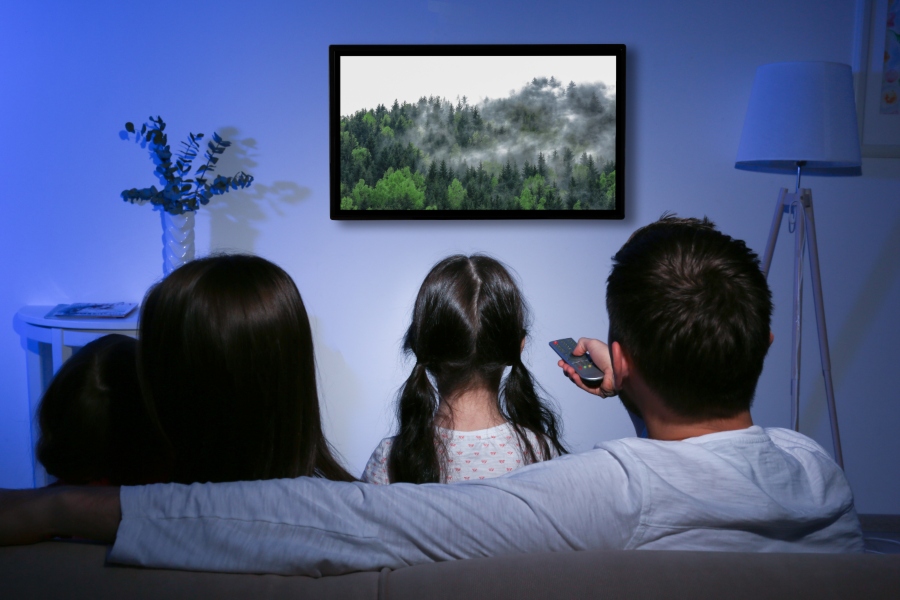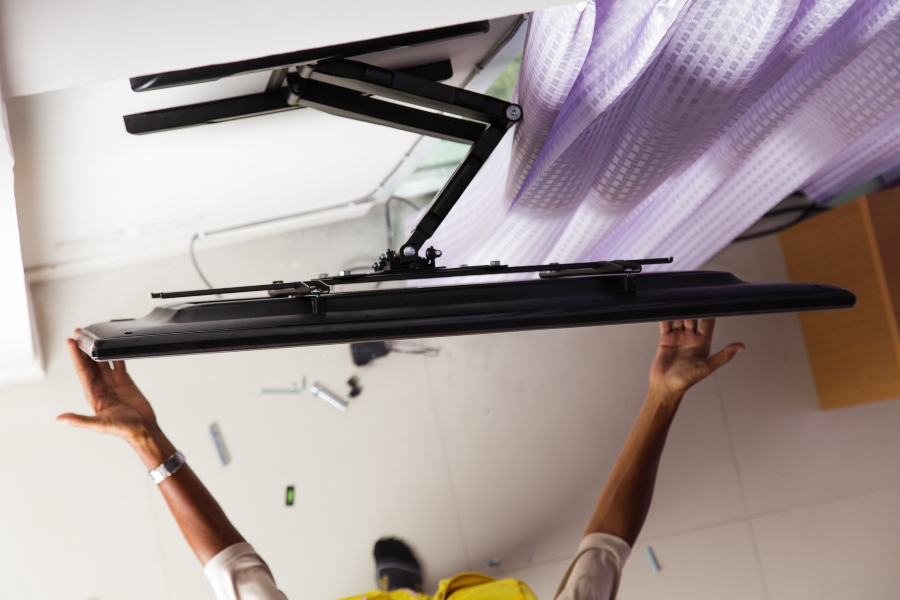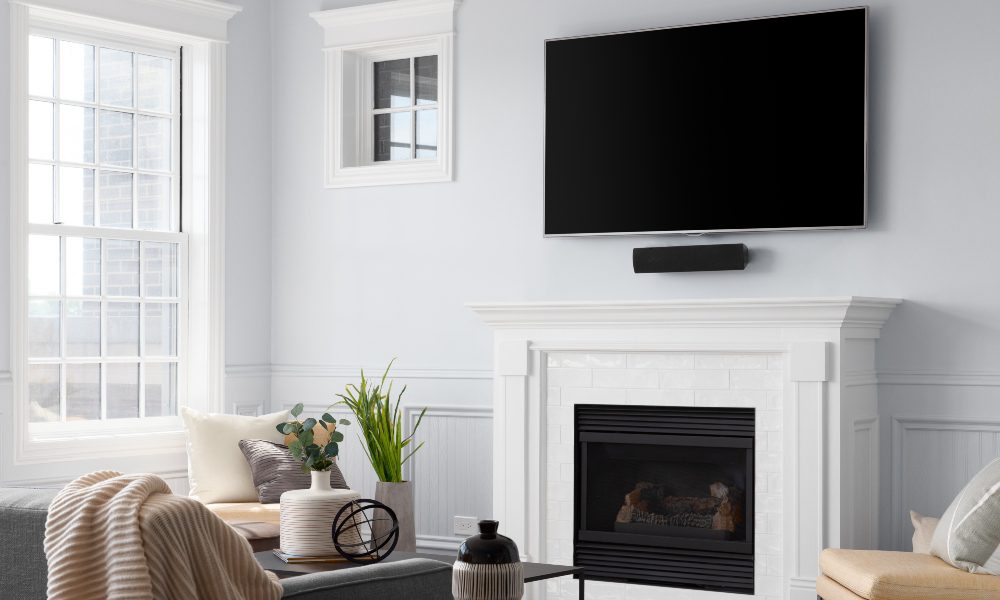One of the first few questions people ask when setting up their home entertainment space is “How high should I mount my TV on the wall,” followed by what the ideal viewing distance is and what’s the best viewing angle. For those who want their viewing experience to be as immersive as possible, positioning is vital. The placement of that TV can mean the difference between an engrossing home theater system or a cricked neck.
As Lee Marc, CEO of MantelMount describes it, “It can feel like you are sitting in the front row of a movie theater. The problems associated with that can be eye strain, chronic neck pain, and chronic back pain. You are also going to degrade the quality of the TV. People spend all this money to get a clear, beautiful picture and then they watch it at an angle that degrades the picture quality.”
To find out how high to mount a TV, the general guidance is that while seated, the center of the TV should be exactly at eye level. However, much like the English language, there are a series of conditionals that come attached to that statement. Room layout, audience positioning, audience height, the size of the TV, and even what type of mount you plan on using can all be influential in determining how high to mount the TV.
To help elucidate both beginners and experts on this topic, CE Pro reached out to Marc and the experts of MantelMount for additional guidance on how high to mount a TV in a room.
How High to Mount a TV?
To get more in depth, guides often state that you should place any screen up to 85-inches in diagonal length (which is the general calculation of TV sizes) 42-inches off the ground, from floor to center of the TV.
However, others will contend that, when mounting a TV to a wall, you should place the screen high enough that, when seated, the bottom of the TV is just eye level, and when standing, the top of the TV is at eye level. The reason for this is that, using the general guidelines above, many of the larger TVs will end up with very little floor clearance once installed, which can be problematic for accumulation of dirt, furniture placement, etc.

For Marc and the experts over at MantelMount, they’ve developed a set of recommended TV mount heights based on their experience working on projects over the years. These vary slightly from the generally recommended heights and therefore allow for greater floor clearance while still maintaining a comfortable viewing experience. For instance, a 43-inch TV should be 56 inches from floor to TV center.
A 55-inch TV, meanwhile should be mounted 61-inches high off the ground.
Knowing how high to mount the TV, you can then mark that position on the wall using a simple calculation.
Using a 43-inch TV as an example, you simply take the screen height (22 inches in this case) divide it in half (11 inches) and then subtract it from the recommended mounting height. Using this, you can determine that the bottom of the TV should be 45-inches off the ground once mounted, allowing you to mark the wall at that height. The same trick can help determine how high to hang a projection screen as well.
Additional Considerations for Determining Mounted TV Height
Distance from Audience to TV
Another element that’s just as important as figuring out how high to mount the TV is figuring out what the ideal viewing distance for the TV audience is, Marc notes.
Have audiences seated too far from the screen, and it can lead to a lack of immersion when watching movies or shows. However, having the viewing distance be too close to the TV can lead to its own set of issues. It might not ruin your eyesight like your mom once told you, but the associated eye strain will certainly lead to some literal headaches.

Thankfully, there’s a handy method, according to Marc, for calculating the ideal viewing distance based off the size of the TV. Let’s use a 65-inch TV as an example. To calculate the ideal viewing distance for it, all you need to do is divide it by 0.55, meaning the ideal viewing distance is 118 inches (roughly nine feet) away.
For a 55-inch display, that translates to 100 inches, or a little over eight feet of viewing distance. For 42-inches, a 76-inch viewing distance is recommended. No matter what, just divide the display size by 0.55 and you’ll have your ideal viewing distance.
TV Viewing Angle
Finding the best viewing angle for a TV is another issue, Marc notes. This is not often a concern on most mounting projects, but in special scenarios, such as trying to mount a TV over a fireplace or in a corner of the room, viewing angle becomes a core consideration.
If you are using a TV mount that can tilt and swivel, all you need to do is adjust such that the viewer is looking directly at the TV when seated. However, as Marc notes, there are limitations on how much you should angle your TV.

In order to maintain a comfortable viewing experience, you don’t want to have a vertical tilt of more than 15 degrees. Anything steeper than that and heads will be craning too far up to get a good viewing angle of the TV.
For horizontal viewing, Marc recommends no more than a 40-degree angling.
Overall Layout of Room
The layout of the room can be pivotal in determining all the aforementioned metrics because different pieces of furniture and design elements can severely limit where the TV can be mounted. For instance, fireplace mantels generally dictate a mounted TV height far higher than the general recommendation to avoid damage from heat and soot. In this scenario, having something like a drop-down TV mount can help combat the high viewing angle.
Another element to consider is the placement of stands or other types of AV furniture beneath the TV. Say you mount a TV on the wall but choose to store media players and other devices such as speakers or soundbars beneath the TV in a cabinet or dresser on the floor. In that scenario, how high you need to mount the TV will be determined by the height of the furniture and accessories.
This can also lead into how you intend to hook cables up to the TV. If you happen to be running wire behind the wall, this may not be as much of an issue, but for a more traditional install hooked up to a wall outlet, where you choose to place the TV may heavily depend upon available outlets, especially if you want to keep visibility of wires to a minimum.
Installers should also avoid wall locations where the TV will be in direct sunlight as this can not only result in an annoying glare on the TV itself, but the sunlight could potentially damage the TV’s image quality over time if it gets hot enough in that one location.
Still Unsure About How to Mount a TV?
Mounting a TV to a wall is a staple of design nowadays, with it not only serving as a space-saving measure, but also as a form of artistic expression for both client and integrator. Knowing how high to mount a TV is only half of the equation, however. There are plenty of popular TV mounts on the market, but to determine which mounts work the best, CE Pro took a look at what the professionals are using. We also compiled all this information and more into definitive resource for finding, sourcing, and installing a wall-mounted TV in the home, for those who are still getting the hang (sorry) of this CI staple.







